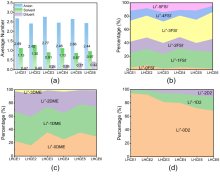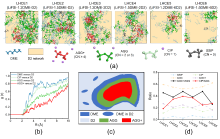Energy Storage Science and Technology
Chao PANG1,2( ), Shuang DING2, Xiaokun ZHANG1(
), Shuang DING2, Xiaokun ZHANG1( ), Yong XIANG1
), Yong XIANG1
Received:2025-02-12
Revised:2025-02-28
Contact:
Xiaokun ZHANG
E-mail:pc11qdu@163.com;zxk@uestc.edu.cn
CLC Number:
Chao PANG, Shuang DING, Xiaokun ZHANG, Yong XIANG. Simulation Study of the Solvation Structure and Ion Migration Behavior in Localized High-Concentration Electrolytes[J]. Energy Storage Science and Technology, doi: 10.19799/j.cnki.2095-4239.2025.0120.
Table 1
Initial molecular numbers of LiFSI, DME, and D2 in different simulation systems"
| 体系(摩尔比) | 缩写 | LiFSI | DME | D2 | |
|---|---|---|---|---|---|
| LCE | LiFSI-9DME | LCE | 60 | 540 | - |
| HCE | LiFSI-1.2DME | HCE1 | 200 | 240 | - |
| LiFSI-1.5DME | HCE2 | 186 | 279 | - | |
| LHCE | LiFSI-1.2DME-D2 | LHCE1 | 115 | 138 | 115 |
| LiFSI-1.5DME-D2 | LHCE2 | 110 | 165 | 110 | |
| LiFSI-1.2DME-2D2 | LHCE3 | 80 | 96 | 160 | |
| LiFSI-1.5DME-2D2 | LHCE4 | 78 | 118 | 156 | |
| LiFSI-1.2DME-6D2 | LHCE5 | 35 | 42 | 210 | |
| LiFSI-1.5DME-6D2 | LHCE6 | 32 | 48 | 192 |

Figure 2
Analysis of Li+ solvation structures in six LHCE systems: LHCE1/3/5: LiFSI-1.2DME-xD2; LHCE2/4/6: LiFSI-1.5DME-xD2 (diluent molar ratio x = 1, 2, 6). (a) Average coordination numbers of Li+ with anions (FSI⁻), solvent (DME), and diluent (D2). (b) Probability distribution of Li+ –FSI⁻ coordination numbers. (c) Probability distribution of Li+ –DME coordination numbers. (d) Probability distribution of Li+ –D2 coordination interactions."


Figure 3
MD simulations of LHCE systems with varied compositions: LHCE1/3/5: LiFSI-1.2DME-xD2; LHCE2/4/6: LiFSI-1.5DME-xD2 (diluent molar ratio x = 1, 2, 6). (a) Snapshots of spatial distributions for cluster types (SSIP, CIP, AGG, AGG+) and DME molecules. (b) RDFs of DME-D2, CIP-D2, AGG-D2, and AGG+-D2 pairs. (c) Schematic spatial partitioning: blue (Li+ –DME coordination), green (AGG clusters), red (AGG+ clusters), with free DME (blue ellipse) in the D2 diluent phase. (d) Ratios of SSIP, CIP, AGG, AGG+ clusters and CIP/AGG, AGG+/AGG transitions."

| 1 | 陆洋, 闫帅帅, 马骁, 等. 低温锂电池电解液的研究与应用 [J]. 储能科学与技术, 2024, 13(7): 2224-2242. |
| Yang LU, Shuaishuai YAN, Xiao MA, Zhi LIU, Weili ZHANG, Kai LIU. Low-temperature electrolytes and their application in lithium batteries[J]. Energy Storage Science and Technology, 2024, 13(7): 2224-2242. | |
| 2 | DIEDERICHSEN K M, MCSHANE E J, MCCLOSKEY B D. Promising Routes to a High Li+ Transference Number Electrolyte for Lithium Ion Batteries [J]. ACS Energy Letters, 2017, 2(11): 2563-75. |
| 3 | ZHOU P, ZHANG X, XIANG Y, et al. Strategies to enhance Li+ transference number in liquid electrolytes for better lithium batteries [J]. Nano Research, 2023, 16(6): 8055-71. |
| 4 | YAO N, YU L, FU Z-H, et al. Probing the Origin of Viscosity of Liquid Electrolytes for Lithium Batteries [J]. Angewandte Chemie International Edition, 2023, 62(41): e202305331. |
| 5 | CHEN J, ZHANG H, FANG M, et al. Design of Localized High-Concentration Electrolytes via Donor Number [J]. ACS Energy Letters, 2023, 8(4): 1723-34. |
| 6 | REN F, LI Z, CHEN J, et al. Solvent–Diluent Interaction-Mediated Solvation Structure of Localized High-Concentration Electrolytes [J]. ACS Applied Materials & Interfaces, 2022, 14(3): 4211-9. |
| 7 | PARK E, PARK J, LEE K, et al. Exploiting the Steric Effect and Low Dielectric Constant of 1,2-Dimethoxypropane for 4.3 V Lithium Metal Batteries [J]. ACS Energy Letters, 2023, 8(1): 179-88. |
| 8 | HOSSAIN M J, WU Q, MARIN BERNARDEZ E J, et al. The Relationship between Ionic Conductivity and Solvation Structures of Localized High-Concentration Fluorinated Electrolytes for Lithium-Ion Batteries [J]. The Journal of Physical Chemistry Letters, 2023, 14(34): 7718-31. |
| 9 | PEREZ BELTRAN S, CAO X, ZHANG J-G, et al. Influence of diluent concentration in localized high concentration electrolytes: elucidation of hidden diluent-Li+ interactions and Li+ transport mechanism [J]. Journal of Materials Chemistry A, 2021, 9(32): 17459-73. |
| 10 | EFAW C M, WU Q, GAO N, et al. Localized high-concentration electrolytes get more localized through micelle-like structures [J]. Nature Materials, 2023, 22(12): 1531-9. |
| 11 | CAO X, ZOU L, MATTHEWS B E, et al. Optimization of fluorinated orthoformate based electrolytes for practical high-voltage lithium metal batteries [J]. Energy Storage Materials, 2021, 34: 76-84. |
| 12 | LI Q, LIU G, CHENG H, et al. Low-Temperature Electrolyte Design for Lithium-Ion Batteries: Prospect and Challenges [J]. Chemistry – A European Journal, 2021, 27(64): 15842-65. |
| 13 | CAO X, JIA H, XU W, et al. Review—Localized High-Concentration Electrolytes for Lithium Batteries [J]. Journal of The Electrochemical Society, 2021. |
| 14 | MARTíNEZ L, ANDRADE R, BIRGIN E G, et al. PACKMOL: A package for building initial configurations for molecular dynamics simulations [J]. Journal of Computational Chemistry, 2009, 30(13): 2157-64. |
| 15 | BERENDSEN H J C, VAN DER SPOEL D, VAN DRUNEN R. GROMACS: A message-passing parallel molecular dynamics implementation [J]. Computer Physics Communications, 1995, 91(1): 43-56. |
| 16 | DODDA L S, CABEZA DE VACA I, TIRADO-RIVES J, et al. LigParGen web server: an automatic OPLS-AA parameter generator for organic ligands [J]. Nucleic Acids Research, 2017, 45(W1): W331-W6. |
| 17 | PODGORŠEK A, SALAS G, CAMPBELL P S, et al. Influence of Ionic Association, Transport Properties, and Solvation on the Catalytic Hydrogenation of 1,3-Cyclohexadiene in Ionic Liquids [J]. The Journal of Physical Chemistry B, 2011, 115(42): 12150-9. |
| 18 | NOSE S. A UNIFIED FORMULATION OF THE CONSTANT TEMPERATURE MOLECULAR-DYNAMICS METHODS [J]. JOURNAL OF CHEMICAL PHYSICS, 1984, 81(1): 511-9. |
| 19 | BERENDSEN H B, HJC). MOLECULAR-DYNAMICS WITH COUPLING TO AN EXTERNAL BATH [J]. JOURNAL OF CHEMICAL PHYSICS, 1984, 81(8: 3684-90. |
| 20 | HUMPHREY W, DALKE A, SCHULTEN K. VMD: Visual molecular dynamics [J]. Journal of Molecular Graphics, 1996, 14(1): 33-8. |
| 21 | WANG Y, LI Z, HOU Y, et al. Emerging electrolytes with fluorinated solvents for rechargeable lithium-based batteries [J]. Chemical Society Reviews, 2023, 52(8): 2713-63. |
| 22 | YAMADA Y, WANG J, KO S, et al. Advances and issues in developing salt-concentrated battery electrolytes [J]. Nature Energy, 2019, 4(4): 269-80. |
| 23 | SELF J, FONG K D, PERSSON K A. Transport in Superconcentrated LiPF6 and LiBF4/Propylene Carbonate Electrolytes [J]. ACS Energy Letters, 2019, 4(12): 2843-9. |
| 24 | DOKKO K, WATANABE D, UGATA Y, et al. Direct Evidence for Li Ion Hopping Conduction in Highly Concentrated Sulfolane-Based Liquid Electrolytes [J]. J Phys Chem B, 2018, 122(47): 10736-45. |
| 25 | YAO N, CHEN X, SUN S-Y, et al. Identifying the lithium bond and lithium ionic bond in electrolytes [J]. Chem, 2025, 11(1): 102254. |
| 26 | 何一涛, 丁飞, 林立, 等. 电极界面浓差极化对锂金属沉积的影响. 物理化学学报[J], 2021, 37(2): 2009001. |
| He Yitao. Influence of Interfacial Concentration Polarization on Lithium Metal Electrodeposition. Acta Physico-Chimica Sinica[J], 2021, 37(2): 2009001. |
| [1] | Yijie YAO, Junwei ZHANG, Yanjun ZHAO, Hongcheng LIANG, Dongni ZHAO. Effect of interfacial dynamics on low temperature performance of sodium-ion batteries [J]. Energy Storage Science and Technology, 2025, 14(1): 30-41. |
| [2] | Guobing ZHOU, Shenzhen XU. Progress of theoretical studies on the formation and growth mechanisms of solid electrolyte interphase at lithium metal anodes [J]. Energy Storage Science and Technology, 2024, 13(9): 3150-3160. |
| [3] | Yang LU, Shuaishuai YAN, Xiao MA, Zhi LIU, Weili ZHANG, Kai LIU. Low-temperature electrolytes and their application in lithium batteries [J]. Energy Storage Science and Technology, 2024, 13(7): 2224-2242. |
| [4] | Chenyang ZHAO, Xiaokun YU, Yubing TAO. Preparation and characterization of modified CuO nanoparticles/n-octadecane phase change material [J]. Energy Storage Science and Technology, 2024, 13(6): 1786-1793. |
| [5] | Heqing TIAN, Zhaoyang KOU, Junjie ZHOU, Yinsheng YU. Molecular dynamics simulation of structure and thermal properties of LiCl-KCl molten salt nanofluids [J]. Energy Storage Science and Technology, 2023, 12(3): 654-660. |
| [6] | Huimin ZHANG, Jing WANG, Yibo WANG, Jiaxin ZHENG, Jingyi QIU, Gaoping CAO, Hao ZHANG. Multiscale modeling of the SEI of lithium-ion batteries [J]. Energy Storage Science and Technology, 2023, 12(2): 366-382. |
| [7] | Dianwei FU, Cancan ZHANG, Heya NA, Guoqiang WANG, Yuting WU, Yuanwei LU. Review of the molecular dynamics of molten salt thermal physical properties [J]. Energy Storage Science and Technology, 2023, 12(12): 3873-3882. |
| [8] | Liangtao XIONG, Jifen WANG, Huaqing XIE, Xuelai ZHANG. Effect of vacancy defects on thermal conductivity of single-layer graphene by molecular dynamics [J]. Energy Storage Science and Technology, 2022, 11(5): 1322-1330. |
| [9] | Peiping YU, Liang XU, Bingyun MA, Qintao SUN, Hao YANG, Yue LIU, Tao CHENG. Multiscale simulation of a solid electrolyte interphase [J]. Energy Storage Science and Technology, 2022, 11(3): 921-928. |
| [10] | Min'an YANG, Ning CHEN, Bo WANG, Qian ZHANG, Jingpei CHEN, Hailei ZHAO, Fushen LI. Gene law about cycle stability of cathode material for lithium-ion batteries [J]. Energy Storage Science and Technology, 2021, 10(2): 462-469. |
| [11] | ZHANG Xuelai, WANG Xuzhe, WANG Jifen, XU Xiaofeng, HUA Weisan, FANG Manting. Molecular dynamics simulation of phase transformation process of n-tetradecane [J]. Energy Storage Science and Technology, 2019, 8(5): 874-879. |
| [12] | YU Jiapeng, CHENG Xiaomin, LI Yuanyuan, LI Bei, XU Hong. Molecular dynamics simulation of thermodynamic properties of Mg-Cu alloys [J]. Energy Storage Science and Technology, 2019, 8(4): 772-777. |
| [13] | CHEN Bingbing, ZHAO Jinwen, MA Jun, CUI Guanglei. Relationship of ion transport and pressure in PEO/LITFSI solid electrolytes [J]. Energy Storage Science and Technology, 2018, 7(3): 431-436. |
| [14] | NI Haiou, SUN Ze, LU Guimin, YU Jianguo. Molecular dynamics simulation of structure and physical properties of NaNO3-KNO3-NaNO2 ternary phase-change molten salts [J]. Energy Storage Science and Technology, 2017, 6(4): 669-674. |
| [15] | HUANG Jie, LING Shigang, WANG Xuelong, JIANG Liwei, HU Yongsheng, XIAO Ruijuan, LI Hong. Fundamental scientific aspects of lithium ion batteries(ⅩⅣ)—Calculation methods [J]. Energy Storage Science and Technology, 2015, 4(2): 215-230. |
| Viewed | ||||||
|
Full text |
|
|||||
|
Abstract |
|
|||||
